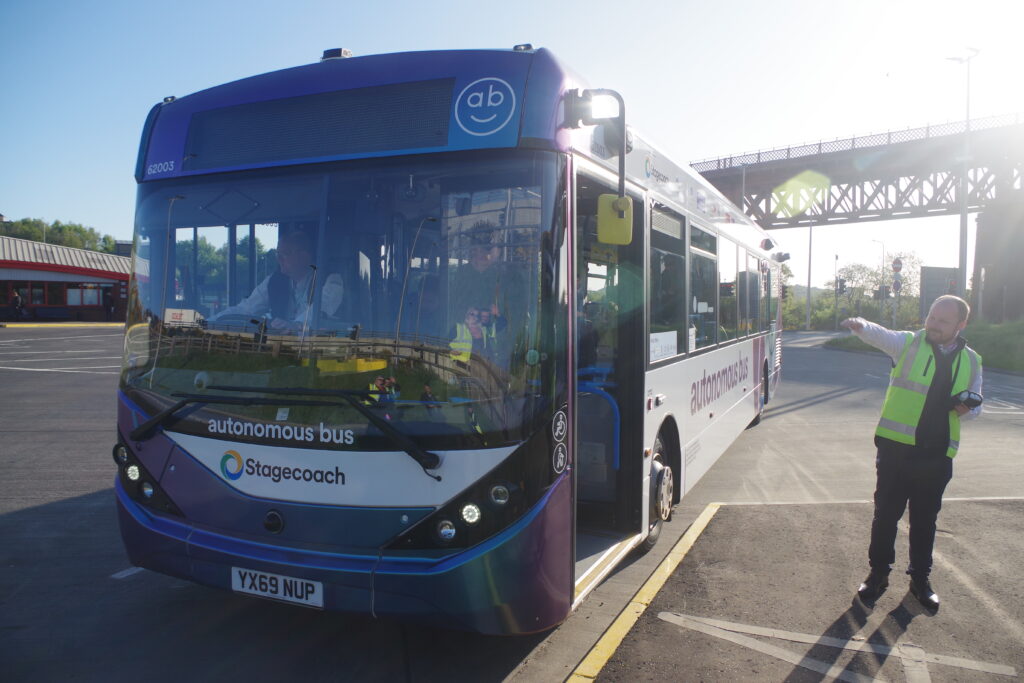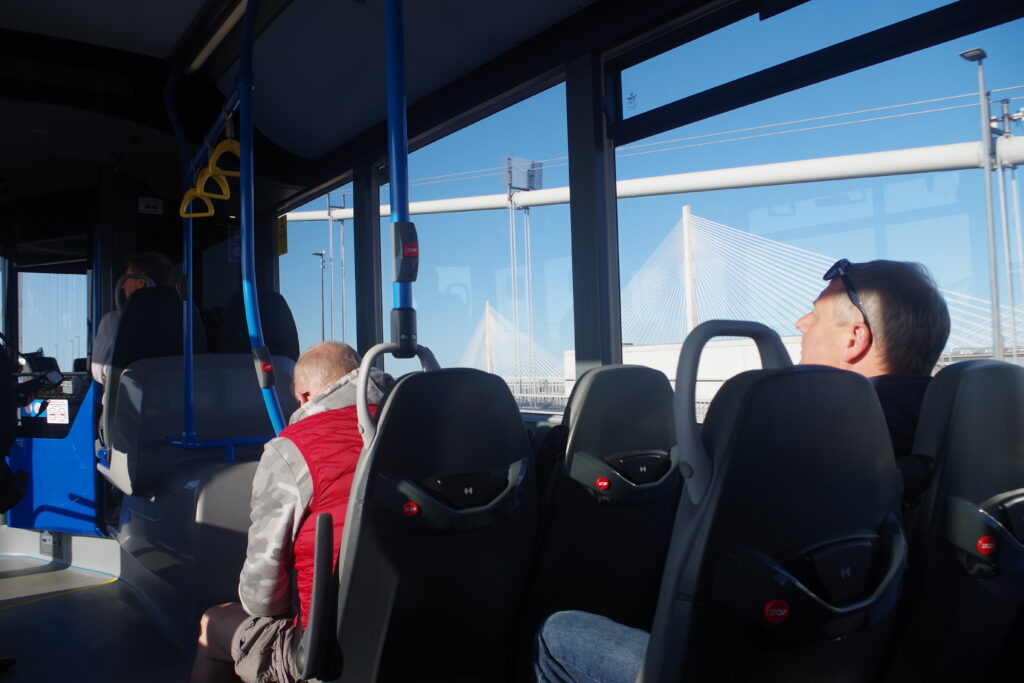Yesterday morning, my son and I got up very early to sample the first passenger-carrying run of a new form of public transport – the UK’s first autonomous bus service. For the first time in this country, you can now travel on an automated road vehicle as a fare-paying passenger. The service is Stagecoach route AB1, from the Ferrytoll Park and Ride in Fife to Edinburgh Park. The fourteen-mile journey takes half an hour.
We were determined to be on the VERY first bus, which left Ferrytoll at 07.30, and we had no idea how busy it would be. As a result, we left home very early for the ten-minute drive, hoping to make sure we were near the front of the queue if a lot of people showed up. When we got to the colourfully-branded bus stop dedicated to the route at about 6.15, we were the only people there, and remained so for some time! However, a group of other people showed up before the bus came along, and it was interesting to chat to them before we boarded. Some were interested specifically in the technology, others were transport enthusiasts, and some, like me, had a professional interest. That said, I’m a huge geek as well, and my enthusiasm for things technical and transport-related was a big draw. I also love sampling firsts of any kind! Being so close to home, this was far too good to resist.
A fair few Stagecoach staff showed up to see us off, and the bus appeared at about 7.15, attracting a lot of interest from the gathered crowd! My son and I boarded first, and were photographed as we did so.

The vehicles themselves are running on 69 plates, so are now getting on for four years old – this has been quite a long development process. Contrary to what you might expect, they’re not electric – they’re powered by conventional diesel engines. From the outside, they look like very typical buses of modern design, but have a selection of sensors and cameras on each corner to handle the automation.
Despite the vehicles being loaded with modern tech, Stagecoach has brought back something quite old-fashioned for this service – the bus conductor! You take your seat and pay as this second member of staff comes round to collect fares and check tickets. I suspect this is part of a “charm offensive” – public opinion is somewhat divided on autonomous vehicles, with safety concerns and worries about job security, so having someone on board dedicated to customer service presents a friendly face. There is also still a driver on board, sat in the cab as you would expect – as it happens, not all the route is automated yet, and it’s also necessary for human intervention should something not go to plan.
The buses have quite a high-spec interior, with USB sockets and wireless charging built into the back of the comfortable leather seats. Seat belts are also fitted, which we were told to put on before the bus set off.

The bus soon set off from the bus terminal at the park and ride, and headed onto the Forth Road Bridge, which is now a dedicated route for buses only. We then headed out onto the motorway towards Hermiston Gait. It was at this point that the conductor advised us we’d entered autonomous mode – it was indicated by a distinctive beep from the cab.
As we were heading towards Edinburgh in the morning rush hour, the motorway was busy, and it was very interesting to observe the way the vehicle behaved. Automatic acceleration and braking is pretty cautious, and keeps the bus well clear of other vehicles, both in front and to the sides. Distinctive quite firm braking kicked in as a large lorry passed very close to the side of us, and on another occasion as a vehicle overtook us and pulled into our lane in front of us. I can see why we were asked to wear seat belts, and I do wonder if standing passengers will be allowed.
The driving computer systems are fully aware of the speed limits on the route, and can also scan the electronic screens above the carriageway for any temporary speed restrictions that may be in force. In time, the plan is for buses to react automatically to traffic lights too, although at the moment the only ones on the route are on the manually-driven sections at each end.
I can see why these still need to be handled by humans – there’s several complex junctions and roundabouts involved, requiring the bus to mix much more closely with complex flows of traffic. The on-board systems will need to make far more calculations and be aware of many more hazards to deal with this satisfactorily. However, the plan is to gradually up the level of automation and extend it to other parts of the route in time. Obviously there’s a lot to monitor and study – the vehicles have been on trial for many months, but it’s only as they run in service, day-in day-out, that it will be possible to understand how well they work, and what the implications are for adopting this technology more widely.
We soon arrived at Edinburgh Park, where a small crowd was waiting to take the bus on its return journey, but we adjourned for some breakfast before taking the second departure back again. We were travelling with conductor Derek, a hugely knowledgeable and experienced driver who told us lots of interesting things about how it all worked. He’s been a bus driver for many years, and involved in the project to bring route AB1 to us for some time. We picked his brains for the whole journey!

Everyone was keen to know what we thought of everything, so there were questionnaires being handed out, and people being urged to undertake online surveys. This is, of course, very important – new developments can be controversial, and it’s important to bring the public with you when doing something like this. In 2010, I did some work for Edinburgh Trams at a time when the construction project was mired in scandal and controversy, and a charm offensive was deemed necessary. Surveys are an important part of this work if you’re going to address problems and gain support and trust.
One question the survey asked was whether I’d be happy to take an autonomous bus with no staff on board at all. I think I’d have to say no, but my concern with that is possibly more closely linked to personal security and anti-social behaviour than it is to the reliability of the technical systems. At the moment, that sort of development feels a very long way away anyway, but what I can see happening in a reasonable timescale is an empty cab, but a member of staff being on-board in a customer service capacity, in much the same way that Docklands Light Railway trains don’t have drivers but have Passenger Service Agents, who can deal with common failures and emergencies.
Of course, a very legitimate concern people have about automation like this is job security, and doing people out of jobs. I completely get that, and in many situations I resist automation and will always choose to deal with a human. However, bus driving is a demanding and stressful job, and there are always vacancies for bus drivers that will never get filled. It’s a tiring job that often involves working antisocial hours, and the fatigue that creates can lead to accidents. If you can make the job less tiring and less demanding, you’ll make buses safer, and make people more willing to jump into the driver’s seat if some of the risks and stresses are reduced. I’m of the opinion this can only be a good thing. There’s also potential for vehicles to be driven more efficiently and economically, making public transport greener than it already is.
High levels of automation in public transport are nothing new – the UK’s first major automatic public transport system was London Underground’s Victoria Line, which opened in 1968. Since then, Automatic Train Operation, largely pioneered by London Transport, has spread to all lines apart from the Bakerloo, Piccadilly and Waterloo & City. Automatic trains also operate on the Glasgow Subway and in Docklands, of course, and on the national rail network they operate on the very busy Thameslink Core in central London. Automating a railway is a relatively easy task, though – you can predict and control what happens on a system like that. It’s much harder on a road. However, there are solutions in the pipeline that could make a completely automated road system viable – one of my fellow passengers on the bus yesterday works for a company developing vehicle automation and communication systems. A road system where autonomous vehicles communicate with each other, and systems like traffic lights, is completely feasible and will probably happen sooner or later. The seemingly-ordinary bus trip I took yesterday was an important part of the journey to get there.